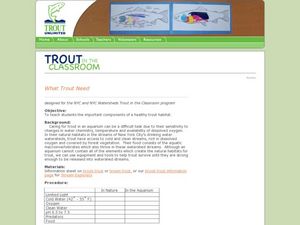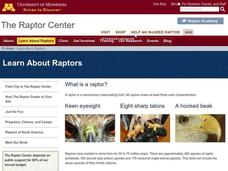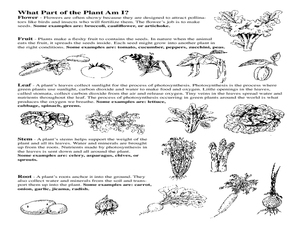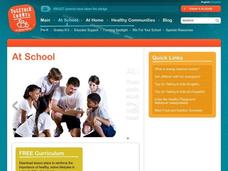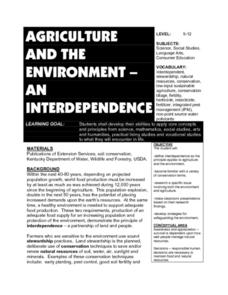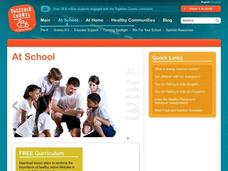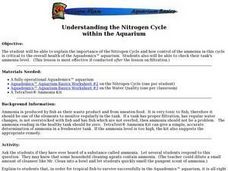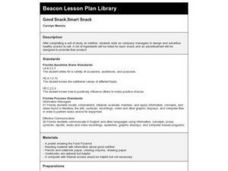Curated OER
What Trout Need
Students investigate the important components for a healthy trout habitat. In this fish habitat lesson, students discuss how the aquarium will simulate a trout's environment in nature. Students complete a trout information sheet to set...
Curated OER
Eat Your Sprouts Part I
Students will conduct a lab on the oxidation of an apple. The students will learn that the oxidation process can be halted when lemon juice is applied to the flesh of an apple because the lemon juice contains vitamin C, an antioxidant....
Curated OER
How Can We Prevent Type 2 Diabetes
Students summarize research they have conducted on Type 2 Diabetes. Students identify healthy lifestyle choices and set goals for their personal health. Students reflect on their research findings in a journal entry.
Curated OER
River Study
Students study physical features of a local stream. They study how to identify water features on topographic maps.
Curated OER
Goobers. Goobers? Goobers!
Students begin the activity by noting the many ways in which to use peanuts. In groups, they use the internet to research the work of George Washington Carver. They discover the allergies and nutritional information of the peanut and...
Curated OER
Laws of the Jungle
Students build a video game on predator-prey relationship. In this biology lesson, students identify the variables that affect this relationship. They write a short description and play each other's game.
Curated OER
Plant Party
Students identify plant parts. In this plants lesson, students bring in a vegetable. Each student classifies which part of the plant their vegetable comes from (flower, root, ect.) Students identify the parts of their vegetable and later...
Curated OER
Physical Activity and Energy
Does smiling take as much energy as running a lap around the track? Everything the body does requires energy. The more vigorous the activity, the more energy the body requires to perform the activity. Compare different low-energy...
Curated OER
Agriculture and the Environment
Students investigate the interdependence of agriculture and the environment. They research areas of interdependence and provide examples of situations where farmers are practicing conservation in the local area. Their findings are...
Curated OER
How Balanced Are You?
Help young learners look at energy in and energy out. Discuss how different activities may require different amounts of energy in. Use the included worksheet to have them write or draw pictures of what they ate in one day and what...
Curated OER
Animal Rights Vs. Animal Welfare - Understanding the Issue
Students explore the difference between animal rights and animal welfare. They take a field trip to a farm to explore the producing animals for human use. After researching and collecting information from animal welfare/rights...
Curated OER
Share Classroom Fat Data with Other Students
Students research eating habits in different places and in different cultures.
Curated OER
Math Nutrition
Fifth graders use nutritional knowledge to plan balanced meals and use grocery store flyers to calculate costs of the meals. They create word problems using these flyers.
Curated OER
Fit For Life: Eat Smart and Exercise
Students examine the problem of obesity among teenagers. They view a video and discuss what could be done to avoid becoming overweight. They also explore the importance of exercise.
Curated OER
Keeping Your Heart in Good Shape: What are the Benefits? - Biology Teaching Thesis
Learners name the main parts of the heart and what events occur there. They write a reaction that contains complete sentences, and uses proper spelling and grammar, after viewing a video. Students define the following terms: contraction,...
Curated OER
Dirty Mud
Students examine geological information to study benthic marine habitats. In this watershed project, students examine wetland habitats and land uses in a watershed. They will use geological information to discuss the impact of pollution...
Curated OER
ENGINEERING TOOTHPASTE
Students make a class list of household products and discuss how many of these products are made through chemistry. They guess the ingredients in the products and imagine how toothpaste might be made. They make toothpaste.
Curated OER
Heart 2: Changing Lifestyles and Heart Health
Students examine and evaluate changes in diet and lifestyle from prehistoric to modern times and how these differences have spurred the development (and better treatment) of heart disease.
Curated OER
Heart 1: Transplant
Students explain the workings and anatomy of the heart and to explore new medical techniques that help people live longer, healthier lives.
Curated OER
Thanksgiving Friends
Students listen to teacher read alouds of books that include facts about Thanksgiving. They discuss what they are thankful for and share this discussion with another class through e-mail.
Curated OER
Nutrition Decision
Students act as decision makers and research and determine the nutritional needs of young children, teenagers, and adults. They compile their findings in a nutrition portfolio. Class groups assume the role of hospital dietician and plan...
Curated OER
Understanding the Nitrogen Cycle within the Aquarium
Young scholars discuss ammonia, and ways it may get into the aquarium. They complete a worksheet about the Nitrogen Cycle. Students learn how to get the ammonia and nitrite out of their aquarium.
Curated OER
Good Snack,Smart Snack
Second graders pretend to be company managers who design and advertise healthy snacks to sell.
Curated OER
Nutrition and the Media: Cereal Box Consumerism
How many treats do you buy each week? Learners investigate diets and how the media tricks consumers into purchasing unhealthy snacks. They will investigate the designs and logos affiliated with cereal boxes and identify specific phrases...


